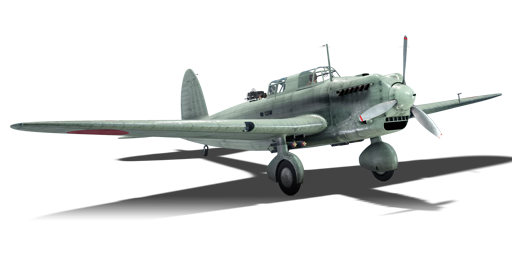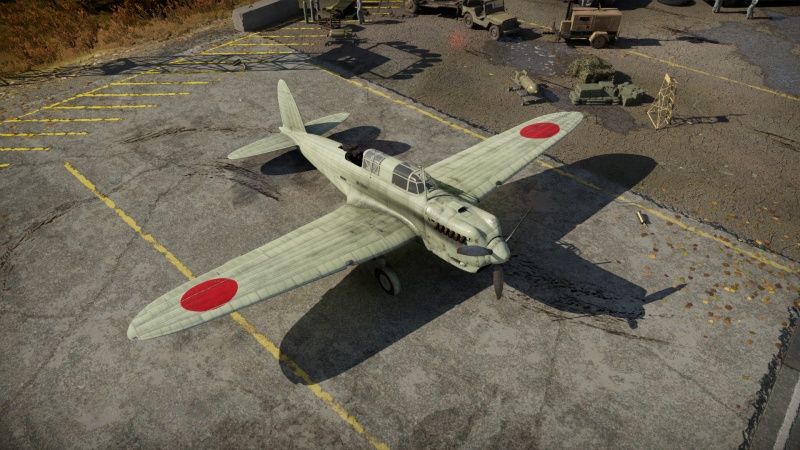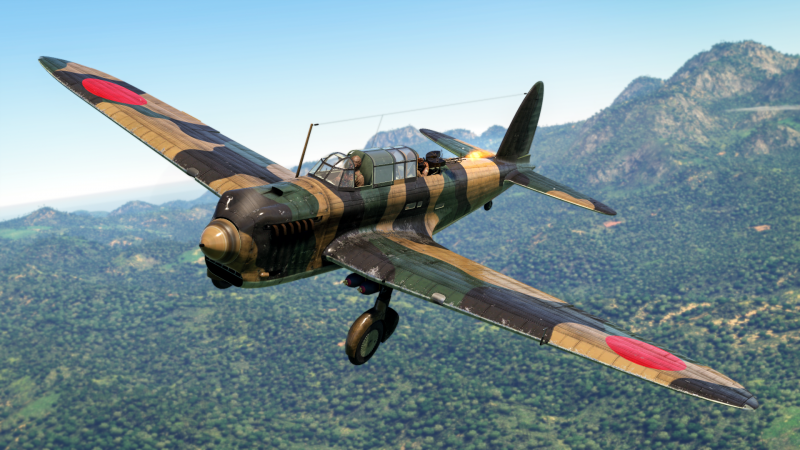Difference between revisions of "Ki-32"
(→Description) |
Inceptor57 (talk | contribs) m (→Description) |
||
| Line 8: | Line 8: | ||
The Ki-32 was a Japanese light bomber developed in 1936 as a replacement for the Kawasaki Ki-3. The specification called for a top speed of 400 km/h at 3,000 m, ability to climb to an altitude of 3,000 m within 8 minutes, be powered by either the 825 hp Mitsubishi Ha-6 radial, 850 hp Nakajima Ha-5 radial, or 850 hp Kawasaki Ha-9-IIb liquid-cooled inline engine, and carry a maximum payload of 450 kg of bombs. Additionally, the specification also called for a single forward-firing machine gun, a rear-facing machine gun on flexible mount, and the ability to perform a 60-degree dive for dive bombing. Production ceased in 1940 with 854 built. The Ki-32 were withdrawn from front-line service in December 1941. | The Ki-32 was a Japanese light bomber developed in 1936 as a replacement for the Kawasaki Ki-3. The specification called for a top speed of 400 km/h at 3,000 m, ability to climb to an altitude of 3,000 m within 8 minutes, be powered by either the 825 hp Mitsubishi Ha-6 radial, 850 hp Nakajima Ha-5 radial, or 850 hp Kawasaki Ha-9-IIb liquid-cooled inline engine, and carry a maximum payload of 450 kg of bombs. Additionally, the specification also called for a single forward-firing machine gun, a rear-facing machine gun on flexible mount, and the ability to perform a 60-degree dive for dive bombing. Production ceased in 1940 with 854 built. The Ki-32 were withdrawn from front-line service in December 1941. | ||
| − | The Ki-32 was introduced in Update 1.79 "Project X" | + | The Ki-32 was introduced in [[Update 1.79 "Project X"]] as the beginning of Japanese dive bomber line. The Ki-32 features a high-altitude bomber spawn, allowing it to reach bases before enemy fighters can climb to intercept it despite its low maximal speed. The single forward-mounted 7.7 mm in a wing could be used for defence as the Ki-32's manoeuvrability allows it to dictate the fight with monoplane contemporaries. The rear-mounted twin 7.7 mm machine guns allow for strong defense against the low rank planes. |
== General info == | == General info == | ||
Revision as of 19:19, 20 March 2023
Contents
Description
The Ki-32 was a Japanese light bomber developed in 1936 as a replacement for the Kawasaki Ki-3. The specification called for a top speed of 400 km/h at 3,000 m, ability to climb to an altitude of 3,000 m within 8 minutes, be powered by either the 825 hp Mitsubishi Ha-6 radial, 850 hp Nakajima Ha-5 radial, or 850 hp Kawasaki Ha-9-IIb liquid-cooled inline engine, and carry a maximum payload of 450 kg of bombs. Additionally, the specification also called for a single forward-firing machine gun, a rear-facing machine gun on flexible mount, and the ability to perform a 60-degree dive for dive bombing. Production ceased in 1940 with 854 built. The Ki-32 were withdrawn from front-line service in December 1941.
The Ki-32 was introduced in Update 1.79 "Project X" as the beginning of Japanese dive bomber line. The Ki-32 features a high-altitude bomber spawn, allowing it to reach bases before enemy fighters can climb to intercept it despite its low maximal speed. The single forward-mounted 7.7 mm in a wing could be used for defence as the Ki-32's manoeuvrability allows it to dictate the fight with monoplane contemporaries. The rear-mounted twin 7.7 mm machine guns allow for strong defense against the low rank planes.
General info
Flight performance
The Ki-32 also is slow even when upgraded. With a stock top speed of 395 km/h and a spaded speed of 423 km/h you will struggle to outrun most monoplanes.
| Characteristics | Max Speed (km/h at 3,950 m) |
Max altitude (metres) |
Turn time (seconds) |
Rate of climb (metres/second) |
Take-off run (metres) | |||
|---|---|---|---|---|---|---|---|---|
| AB | RB | AB | RB | AB | RB | |||
| Stock | 408 | 397 | 7000 | 14.7 | 15.2 | 5.5 | 5.5 | 300 |
| Upgraded | 442 | 423 | 13.1 | 14.0 | 12.4 | 7.6 | ||
Details
| Features | ||||
|---|---|---|---|---|
| Combat flaps | Take-off flaps | Landing flaps | Air brakes | Arrestor gear |
| ✓ | ✓ | ✓ | X | X |
| Limits | ||||||
|---|---|---|---|---|---|---|
| Wings (km/h) | Gear (km/h) | Flaps (km/h) | Max Static G | |||
| Combat | Take-off | Landing | + | - | ||
| 600 | 600 | 564 | 518 | 280 | ~12 | ~9 |
| Optimal velocities (km/h) | |||
|---|---|---|---|
| Ailerons | Rudder | Elevators | Radiator |
| < 290 | < 260 | < 270 | > 312 |
Survivability and armour
One of the two major downfalls of the Ki-32 is the limited protection it has. With an open cockpit, a fuselage made of fabric and wood, and no armour, any plane with guns can shoot it down. However, as noted, the Ki-32 is amazingly manoeuvrable, increasing its survivability if one knows how to use it correctly. It also mounts 2 defensive 7.7 mm Type 89s, which at this rank is quite powerful due to its high fire rate and the large area it can cover.
Modifications and economy
- Being a bomber, acquiring the 10 inch (mod 24) module should be top priority. The weak airframe means that getting the survivability modules will help you survive attacks from unwanted visitors.
- New turret belts are beneficial as the gunner's stock belts contain ball ammunition which is almost useless.
Armaments
Offensive armament
The Ki-32 is armed with:
- 1 x 7.7 mm Type 89 machine gun, wing-mounted (200 rpg)
Suspended armament
The Ki-32 can be outfitted with the following ordnance:
- 9 x 50 kg Army Type 94 GPHE bombs (450 kg total)
- 4 x 100 kg Army Type 94 GPHE bombs (400 kg total)
Defensive armament
The Ki-32 is defended by:
- 2 x 7.7 mm Type 89 machine guns, dorsal turret (270 rpg = 540 total)
Usage in battles
The first thing you will notice upon flying the Ki-32 is that it is incredibly nimble, especially in AB. It can out-turn anything that's not a biplane. A spaded Ki-32 with no bombs can out-turn early Spitfires, and a smart pilot will use this incredible manoeuvrability to their advantage. However, all this manoeuvrability comes at a dangerous cost. With no armour, a vulnerable cockpit, and a weak airframe, you cannot afford to take any damage. As such, you should avoid engagements at all costs.
As a low flying light bomber, your first priority should be bombing ground targets as bombing bases is impractical, due to your bombs dealing low amounts of damage to them. While your 9 x 50 kg bombs are efficient at destroying lightly armoured targets like armoured cars and AAA, and your 100 kg bombs can destroy light tanks, any heavily armoured target like medium and heavy tanks or destroyers will shrug them off unless you score a direct hit, which is relatively easy to do due to the Ki-32's solid bomb accuracy.
Be sure to avoid any form of confrontation. Although you can outmanoeuvre pretty much anything you face, you cannot afford to take any hits, so the best idea is to avoid engagements all-together. However, if an enemy decides that you are worthy prey, you have a few tools at your disposal. Firstly, pull turn heavy manoeuvres and try to get on their tail. While you only have a 7.7 mm machine gun, you may be able to hit critical modules or even snipe the pilot if you are accurate enough. Aim for the pilot, engine(s) and wings, as you have a larger chance of downing an enemy by aiming at these spots. If the enemy is diving on you, force them to overshoot through manoeuvres and effective rudder usage then attempt to disengage during their zoom climb.
Enemies worth noting are as follows:
I-153s/I-16s - The Soviet biplanes and early Chaikas are universally feared planes. You can outmanoeuvre both of them, but they are quite fast for their ranks and sport 2-4 ShKAS machine guns that can mount entirely Incendiary rounds, which will shred your weak fabric and wood body in seconds. These ShKAS machine guns are arguably the best 7.62 mm guns in the game due to their high fire rate, good accuracy, powerful incendiary belts and good stopping power for their rank, so try not to get hit by any shot as they have a high possibility of critically damaging your plane, if not setting it on fire. Avoid them if possible, and if one thrusts a fight on you, seek assistance from teammates. Do not try to engage them, under any circumstances, as only one measly 7.7 mm will not be enough to kill them, and very soon, you will find yourself shot down.
D.501s/D.510s - The Dewoitines are exceptionally dangerous opponents. They are highly manoeuvrable, have decent speed, and are the only planes at this BR to mount a cannon, and what a cannon it is (Hispano 404). A single shot of their Hispano is enough to down your plane. However, their airframe is quite weak overall and have a very vulnerable open cockpit. If one engages with you, attempt to make him use all of his cannon rounds then try to snipe out his pilot with your gunner.
Manual Engine Control
| MEC elements | ||||||
|---|---|---|---|---|---|---|
| Mixer | Pitch | Radiator | Supercharger | Turbocharger | ||
| Oil | Water | Type | ||||
| Not controllable | Controllable Not auto controlled |
Controllable Not auto controlled |
Controllable Not auto controlled |
Separate | Not controllable 1 gear |
Not controllable |
Pros and cons
Pros:
- Fantastic manoeuvrability; can outturn Spitfires with no bombs
- Small target
- Fast firing defensive armament that covers a lot of area
- Minimum fuel load is 35 minutes
- Bombs are very accurate
- Access to a bomb sight, a rarity for single-engined bombers
- Fixed landing gear makes emergency landings easier (and regular landings)
- Slow speed reduces bomb dispersion from the bombsight, unlike faster bombers
- Has some offensive armament unlike most bombers
Cons:
- Weak airframe
- No armour whatsoever
- Slow even after upgrades
- Weak offensive armament
- 4 x 100 kg bombs are useless versus heavy armour
- Fuel tanks are not self-sealing
- Fires will almost certainly down the plane (wood and fabric will not hold up for long)
- It will most likely lose head-ons due to lack of armour and weak offensive armament
- Mediocre roll rate
- Offensive 7.7 mm machine gun is virtually useless other than for ground attacks (and even then, only trucks, artillery and howitzers)
History
The Ki-32 was developed in response to a 1936 Imperial Japanese Army specification to replace the ageing and inferior Ki-3. Both Mitsubishi and Kawasaki were requested to build two prototypes by Christmas. The specification required a top speed of 400 km/h at 3,000 m with a normal operating altitude from 2,000 to 4,000 m and the ability to climb to that height in 8 minutes. The companies needed to choose between utilizing an 825 hp Mitsubishi Ha-6 radial, an 850 hp Nakajima Ha-5 radial or an 850 hp Kawasaki Ha-9-IIb liquid-cooled inline engines.
The bomber also needed to conform to the following parameters:
- Have a normal bomb load of 300 kg
- Have a maximum payload of 450 kg
- One forward firing machine gun
- At least one flexible rear turret
- The ability to perform 60-degree dives for dive bombing
- Have a fully loaded weight of less than 3,300 kg
The first Kawasaki prototype flew in 1937 and seven more prototypes were produced. The Kawasaki Ki-32 and Mitsubishi Ki-30 were virtually identical in terms of layout and performance, the main difference between the two were the engines. Mitsubishi used the Nakajima Ha-5 14-cylinder air-cooled radial engine, whereas Kawasaki opted to use their own Ha-9-IIb inline V12 engine.
The Kawasaki design encountered engine cooling problems, thus awarding the Mitsubishi Ki-30 the production order. Despite this, the need for aircraft in the Second Sino-Japanese war, which had started at full scale in July 1937, allowed the Ki-32 to enter production 12 months behind its rival. However, there were more Ki-32s built than Ki-30 despite being an inferior plane.
The Ki-32 was used extensively during the Sino-Japanese War, equipping the 3rd, 6th, 10th, 35th, 45th, 65th and 75th Sentai. It saw combat during the Battle of Nomonhan against the Soviet Union in 1938-1939. The plane saw its last combat action with the Imperial Japanese Army bombing the Commonwealth forces during the Japanese invasion of Hong Kong.
During WWII, the Ki-32 were supplied to the Manchukuo Air Force in order to replace Kawasaki's old Type 88/KDA-2 light bombers, and were the main bombers of the service through the war.
It was finally withdrawn from military service in 1942 and was re-purposed as a training plane.
Media
- Skins
- Videos
See also
- Aircraft of comparable role, configuration and era
External links
- [Devblog] Kawasaki Ki-32: The Bomber of Three Armies
- Official data sheet - more details about the performance
| Kawasaki Aircraft Industries (川崎航空機工業株式会社) | |
|---|---|
| Biplane Fighters | Ki-10-I · Ki-10-I C · Ki-10-II · Ki-10-II C |
| Fighters | Ki-61-I ko · Ki-61-I otsu · Ki-61-I hei · Tada's Ki-61-I hei · Ki-61-I tei · Ki-61-II Otsu Kai |
| Ki-100 · Ki-100-II | |
| Interceptors | Ki-45 ko · Ki-45 otsu · Ki-45 hei · Ki-45 tei |
| Ki-96 | |
| Ki-102 otsu | |
| Ki-108 Kai | |
| Bombers | Ki-32 |
| Ki-48-II otsu | |
| Captured | ␗Ki-45 hei/tei · ␗Ki-61-I otsu · ▃Ki-61-Ib |
| See also | Kawasaki Shipyard Co. |
| Japan bombers | |
|---|---|
| Navy | |
| Carrier-based attack bomber | |
| B5N | B5N2 |
| B6N | B6N1 · B6N2 · B6N2a |
| B7A | B7A2 · B7A2 (Homare 23) |
| Carrier-based dive bomber | |
| D3A | D3A1 |
| D4Y | D4Y1 · D4Y2 · D4Y3 Ko |
| Shipboard Observation seaplane | |
| F1M | F1M2 |
| Land-based Attack bomber | |
| G4M | G4M1 |
| G5N | G5N1 |
| G8N | G8N1 |
| Flying boat | |
| H6K | H6K4 |
| H8K | H8K2 · H8K3 |
| Land-based Bomber | |
| P1Y | P1Y1 |
| Army | |
| Light | Ki-32 |
| Ki-48-II otsu | |
| Heavy | Ki-21-Ia · Ki-21-I hei |
| Ki-49-I · Ki-49-IIa · Ki-49-IIb · Ki-49-IIb/L | |
| Ki-67-I Ko · Ki-67-I otsu | |
| Other countries | ▅B-17E |






